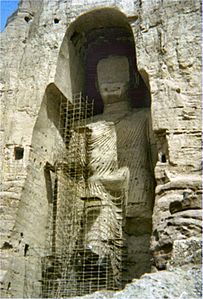Çeviri
coor title dms|34|49|55|N|67|49|36|E|region:AF_type:landmark The Islamist Taliban government decreed that the statues, which had survived intact for over 1,500 years, were idolatrous and un-Islamic. During the destruction, Taliban Information Minister Qudratullah Jamal lamented that, "this work of destruction is not as simple as people might think. You can`t knock down the statues by shelling as both are carved into a cliff; they are firmly attached to the mountain."Fact|date=January 2008 The two largest Buddhas faced dynamite and tank barrages and were demolished after almost a month of intensive bombardment.
A Swiss documentary reported that locals claimed to have seen Pakistani and Saudi engineers on site to help with the destruction of the statues.cite news | last = Hasan| first = Khalid|date=2006-03-19| title = Swiss documentary on Afghanistan: Pakistani, Saudi engineers helped destroy Buddhas| publisher = ``Daily Times ``| url = http://www.dailytimes.com.pk/default.asp?page=2006\03\19\story_19-3-2006_pg7_38| accessdate = 2008-01-06 A Pakistani charity designated a terrorist organization by the US Treasury Department,http://www.ustreas.gov/offices/enforcement/key-issues/protecting/docs/designationsum-.pdf Al Rasheed Trust, based in Karachi, had published a special calendar with photographs to commemorate the destruction.
Restorasyon vaadleri
Though the figures of the two large Buddhas are almost completely destroyed, their outlines and some features are still recognizable within the recesses. It is also still possible for visitors to explore the monks` caves and the passages which connect them. As part of the international effort to rebuild Afghanistan after the Taliban war, the Government of Japan and several other organizations, among them the Afghanistan Institute in Bubendorf, Switzerland, along with the ETH in Zurich, have committed themselves to rebuilding the two largest Buddhas; anastylosis is one technique being considered.2002`deki gelişmeler
In May 2002, a mountainside sculpture of the Buddha was carved out of a mountain in Sri Lanka. It was designed to closely resemble one of the Buddhas of Bamyan.In December 2004, Japanese researchers discovered that the wall paintings at Bamyan were actually painted between the fifth and the ninth centuries, rather than the sixth to eighth centuries as previously believed. The discovery was made by analysing radioactive isotopes contained in straw fibers found beneath the paintings. Further discoveries are expected to be made after comparing the paintings` dates and styles.
The Afghan government has commissioned Japanese artist Hiro Yamagata to recreate the Bamyan Buddhas using fourteen laser systems to project the images of the Buddhas onto the cliff where they once stood. The laser systems will be solar-powered and wind-powered. The project, which will cost an estimated $9 million, is currently pending UNESCO approval. If approved, the project is estimated to be completed by June 2012.
In September 2005, Mawlawi Mohammed Islam Mohammadi, Taliban governor of Bamyan province at the time of the destruction and widely seen as responsible for its occurrence, was elected to the Afghan Parliament. On January 26, 2007, he was gunned down in Kabul on the way to prayers.Fact|date=January 2008
Swiss filmmaker Christian Frei made a 95-minute documentary entitled ``The Giant Buddhas`` (released in March 2006) on the statues, the international reactions to it, and an overview of the controversy. The movie makes the controversial claim (quoting a local Afghan) that the destruction was ordered by Osama Bin Laden and that initially, Mullah Omar and the Afghans in Bamyan had opposed the destruction.cite news |date=2006-03-28| title = Laden ordered Bamiyan Buddha destruction| publisher = ``The Times of India``| url = http://timesofindia.indiatimes.com/articleshow/1466974.cms| accessdate = 2008-01-06
In the summer of 2006, Afghan officials were deciding the timetable for the re-construction of the statues. The mullahs in the province have stated that the destruction was an atrocity and the statues deserve restoration. While they wait for the Afghan government and international community to decide whether to rebuild them, a $1.3 million UNESCO-funded project is sorting out the chunks of clay and plaster - ranging from boulders weighing several tons to fragments the size of tennis balls - and sheltering them from the elements.
Kaynaklar
reflist- Fabio Maniscalco, ``World Heritage and War``, monographic series "Mediterraneum", vol. 6, Naples 2007, Massa Publisher [1]
- `` Japanese researchers make breakthrough on destroyed Bamyan paintings``. Mainichi Shimbun, Japan, 2004-12-11.
- Wriggins, Sally Hovey. ``Xuanzang: A Buddhist Pilgrim on the Silk Road``. Boulder: Westview Press, 1996
- Theosophical website with pictures
- Buddhas of Bamyan and more photographs from Afghanistan
- Artist to recreate Afghan Buddhas. BBC News, 9 August 2005.
- "The Giant Buddhas" trilingual site (English, Deutsch, Français) - a film about the destruction of the giant statues. By Christian Frei, Switzerland (2005).
- imdb title|id=0478157|title=The Giant Buddhas
- "World appeals to Taleban to stop destroying statues". CNN, 3 March 2001. (New York)
- http://www.rediff.com/news/2004/apr/12inter.htm
- Pakistani, Saudi engineers helped destroy BuddhasDaily Times, Sunday, March 19 2006.
- [http://news.yahoo.com/s/ap/20070126/ap_on_re_as/afghanistan "Afghan who had statues destroyed killed", Associated Press, January 26 2007.
- Gall, Carlotta. "Afghans consider rebuilding Bamiyan Buddhas", ``Herald Tribune``, December 5 2006.
- Harding, Luke. " How the Buddha got his wounds ", ``The Guardian``, March 3 2001.
- Kassaimah, Sahar. "Afghani Ambassador Speaks At USC", ``IslamOnline``, March 12 2001.
-->
Linkler
commons|Buddhas of Bamiyan- News articles about the Buddhas of Bamiyan
- Photos of the Buddhas of Bamiyan
- Bamiyan Afghanistan Laser Project
- World Heritage Tour: 360 degree image ``(after destruction)``
- bamiyan-development Community Portal for cultural heritage management of Bamiyan
